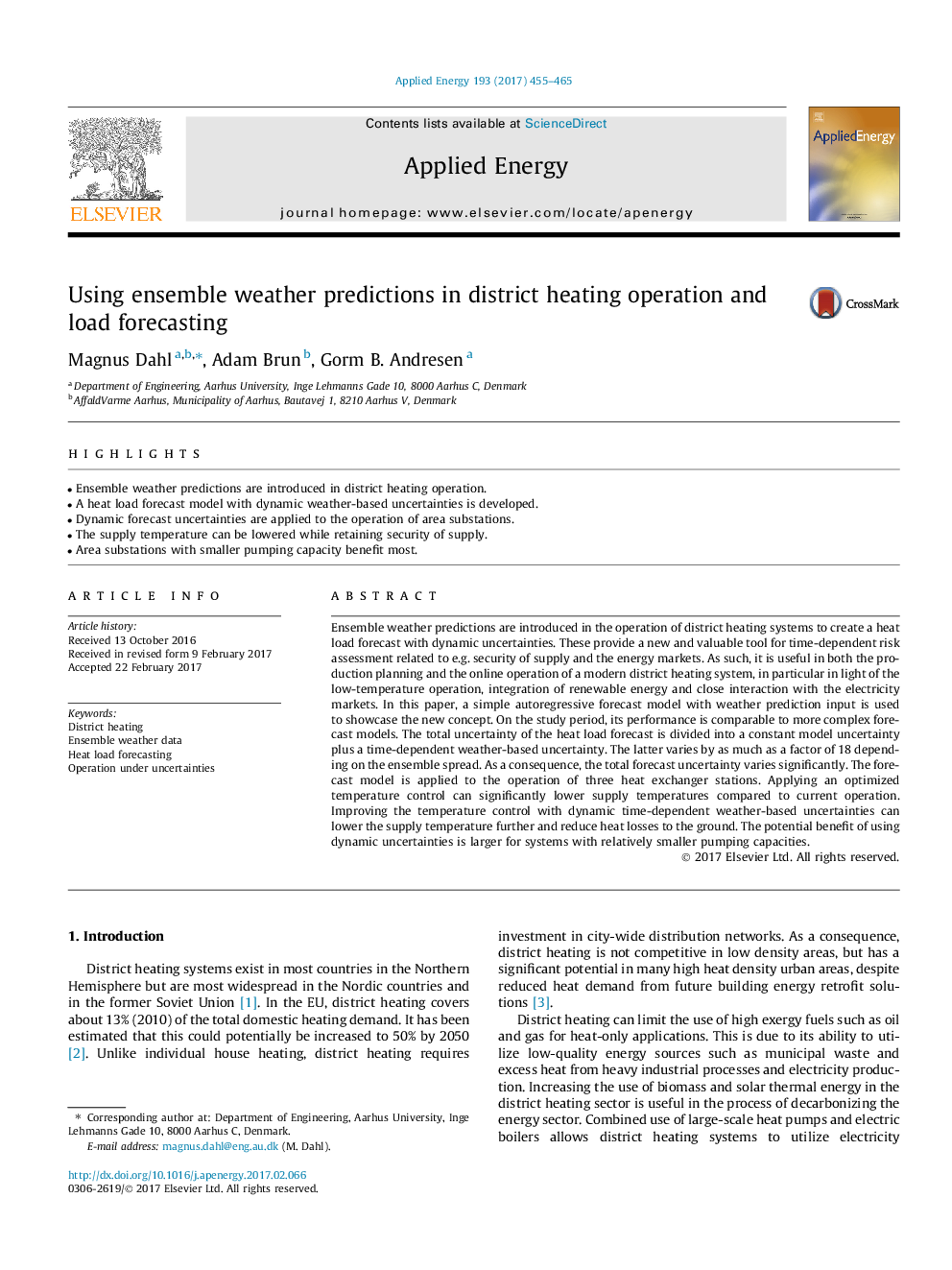| کد مقاله | کد نشریه | سال انتشار | مقاله انگلیسی | نسخه تمام متن |
|---|---|---|---|---|
| 4916316 | 1428097 | 2017 | 11 صفحه PDF | دانلود رایگان |
عنوان انگلیسی مقاله ISI
Using ensemble weather predictions in district heating operation and load forecasting
ترجمه فارسی عنوان
با استفاده از پیش بینی آب و هوای گروهی در عملیات حرارت منطقه ای و پیش بینی بار
دانلود مقاله + سفارش ترجمه
دانلود مقاله ISI انگلیسی
رایگان برای ایرانیان
کلمات کلیدی
گرمایش منطقه، داده های هواشناسی گروه، پیش بینی جریان حرارت، عملیات تحت نامطلوب،
ترجمه چکیده
پیش بینی آب و هوا گروهی در بهره برداری از سیستم های حرارت منطقه ای معرفی شده است تا پیش بینی بار حرارت را با عدم قطعیت پویا ایجاد کند. این ابزار جدید و ارزشمند برای ارزیابی ریسک وابسته به زمان است که به عنوان مثال امنیت تامین و بازارهای انرژی. به همین ترتیب، در برنامه ریزی تولید و عملیات آنلاین سیستم گرمایش مرکزی مدرن، به ویژه در شرایط عملیات کم دما، ادغام انرژی های تجدید پذیر و تعامل نزدیک با بازارهای برق مفید است. در این مقاله، مدل پیش بینی ساده ی خودپژیری با ورودی پیش بینی آب و هوا برای نمایش مفهوم جدید استفاده می شود. در دوره مطالعه، عملکرد آن با مدل های پیش بینی پیچیده تر قابل مقایسه است. عدم اطمینان کل پیش بینی میزان گرما به یک عدم قطعیت مدل ثابت و همچنین عدم وابستگی زمانی وابسته به آب بستگی دارد. با توجه به گسترش گروه، این متغیر به اندازه یک عامل 18 متغیر است. به عنوان یک نتیجه، عدم اطمینان کلی پیش بینی به طور قابل توجهی متفاوت است. مدل پیش بینی شده به بهره برداری از سه ایستگاه مبدل حرارتی اعمال می شود. استفاده از کنترل دما بهینه می تواند به طور قابل توجهی کاهش دمای عرضه در مقایسه با عملیات فعلی. بهبود کنترل دما با عدم وابستگی زمانی وابسته به آب و هوا، می تواند دمای عرضه را کاهش داده و تلفات گرما را به زمین کاهش دهد. مزایای بالقوه استفاده از عدم قطعیت پویا برای سیستم های با ظرفیت های پمپاژ نسبتا کوچک تر است.
موضوعات مرتبط
مهندسی و علوم پایه
مهندسی انرژی
مهندسی انرژی و فناوری های برق
چکیده انگلیسی
Ensemble weather predictions are introduced in the operation of district heating systems to create a heat load forecast with dynamic uncertainties. These provide a new and valuable tool for time-dependent risk assessment related to e.g. security of supply and the energy markets. As such, it is useful in both the production planning and the online operation of a modern district heating system, in particular in light of the low-temperature operation, integration of renewable energy and close interaction with the electricity markets. In this paper, a simple autoregressive forecast model with weather prediction input is used to showcase the new concept. On the study period, its performance is comparable to more complex forecast models. The total uncertainty of the heat load forecast is divided into a constant model uncertainty plus a time-dependent weather-based uncertainty. The latter varies by as much as a factor of 18 depending on the ensemble spread. As a consequence, the total forecast uncertainty varies significantly. The forecast model is applied to the operation of three heat exchanger stations. Applying an optimized temperature control can significantly lower supply temperatures compared to current operation. Improving the temperature control with dynamic time-dependent weather-based uncertainties can lower the supply temperature further and reduce heat losses to the ground. The potential benefit of using dynamic uncertainties is larger for systems with relatively smaller pumping capacities.
ناشر
Database: Elsevier - ScienceDirect (ساینس دایرکت)
Journal: Applied Energy - Volume 193, 1 May 2017, Pages 455-465
Journal: Applied Energy - Volume 193, 1 May 2017, Pages 455-465
نویسندگان
Magnus Dahl, Adam Brun, Gorm B. Andresen,
